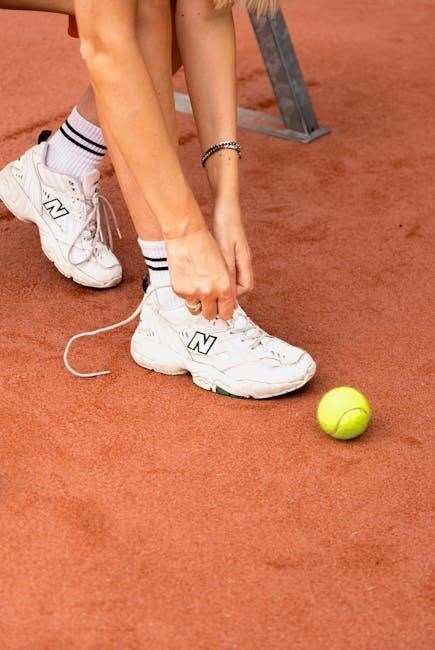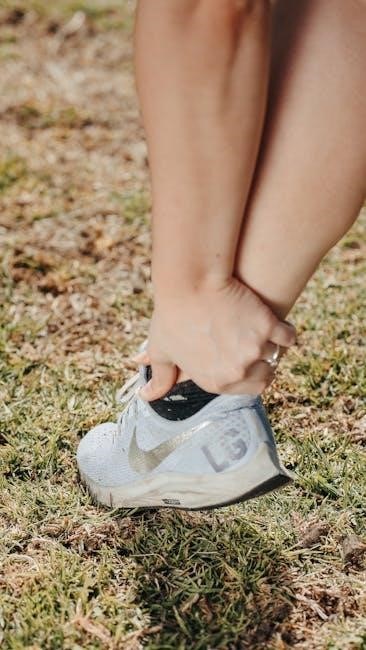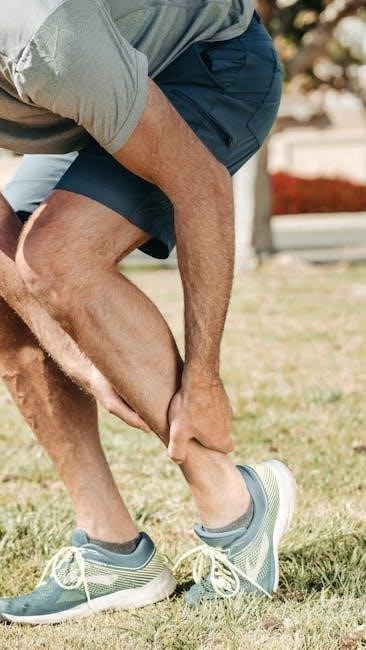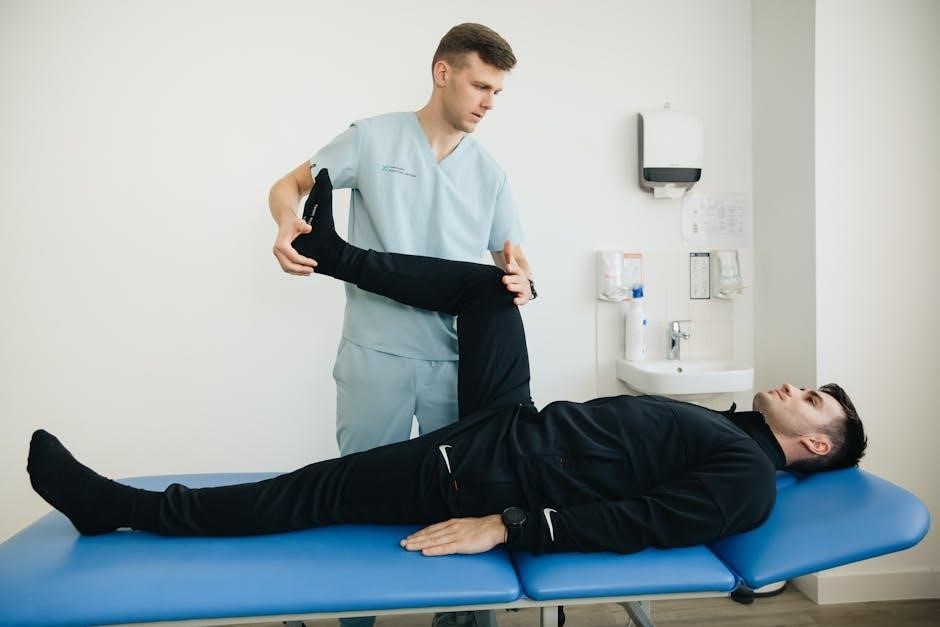Calf strain rehabilitation focuses on restoring strength, flexibility, and function after injury. Early intervention with rest, ice, and gentle exercises promotes recovery and prevents further damage.
Understanding Calf Strains and Their Prevalence
A calf strain, often referred to as “Tennis Leg,” is a common injury involving the tearing of muscle fibers in the gastrocnemius or soleus muscles. It frequently occurs during sudden contractions or overstretching, leading to pain and limited mobility. Calf strains are prevalent among individuals aged 30-45 and are common in sports like tennis, running, and cycling. Activities requiring rapid accelerations or changes in direction increase the risk. Poor flexibility, muscle imbalances, and inadequate warm-ups are key contributing factors. The injury often results in pain, swelling, and difficulty walking. Understanding its causes and risk factors is crucial for effective prevention and rehabilitation strategies. Early diagnosis and proper treatment significantly improve recovery outcomes and reduce the likelihood of recurrence.
Importance of Early Rehabilitation in Calf Strain Recovery
Early rehabilitation is crucial for optimal recovery from calf strains, as it helps restore strength, flexibility, and function. Delayed treatment can lead to prolonged recovery and increased risk of re-injury. Gentle exercises initiated soon after injury improve circulation, reduce muscle atrophy, and promote tissue repair. Early intervention also minimizes scar tissue formation, enhancing muscle elasticity and reducing stiffness. Rehab programs should include controlled stretching and strengthening exercises, such as towel stretches and heel raises, tailored to the injury severity. Adhering to a structured rehab plan ensures a faster return to normal activities and sports, reducing long-term complications. Consistency in early stages lays the foundation for successful recovery.

Phases of Calf Strain Rehabilitation
Calf strain rehabilitation involves structured phases: acute care, gentle stretching, strengthening, and advanced exercises, ensuring gradual progression from pain management to full functional recovery and return to activity.

Acute Phase: Immediate Post-Injury Care
The acute phase focuses on reducing pain and inflammation through rest, ice, compression, and elevation. Gentle exercises like towel stretches can begin once pain subsides, avoiding sharp discomfort. Early mobilization is key.

Gentle Stretching Exercises for the Calf
Gentle stretching is crucial during the early stages of calf strain rehabilitation to improve flexibility and reduce muscle tightness. The towel stretch is a common exercise, where a towel is looped around the foot, and gentle pulls are applied to stretch the calf. This should be held for 15-30 seconds and repeated several times daily. Another effective stretch is the standing calf stretch, performed by leaning against a wall with one leg back, heel on the ground, and bending the front knee. These exercises help restore range of motion without causing further injury. Consistency is key to progress and preventing stiffness.

Standing Calf Stretch: A Core Rehab Exercise
The standing calf stretch is a fundamental exercise in calf strain rehabilitation, targeting the gastrocnemius and soleus muscles. To perform it, face a wall and place your hands at eye level for support. Step one leg back about a foot, keeping the heel on the ground and the knee straight. Slowly bend the front knee, leaning into the wall until a gentle stretch is felt in the back of the calf. Hold for 15-30 seconds, then switch legs. This stretch improves flexibility and reduces tightness, making it an essential part of the recovery process. It is typically introduced after initial pain subsides and basic stretching becomes manageable.

Strengthening Exercises for Calf Strain Recovery
Strengthening exercises, like heel raises and resistance band workouts, are crucial for rebuilding calf muscle strength and promoting full recovery. They help restore function and prevent future injuries.
Heel Raises: A Key Strengthening Exercise
Heel raises are a fundamental strengthening exercise for calf strain recovery. To perform, stand behind a chair or counter for balance. Slowly raise your body onto your tiptoes, hold for 5 seconds, then lower back down. Aim for 3 sets of 10 repetitions daily. This exercise targets the gastrocnemius and soleus muscles, improving strength and stability. Progress gradually by increasing repetitions or adding resistance, such as wearing a weighted backpack. Ensure movements are pain-free to avoid overstraining. Heel raises are essential for restoring calf function and preventing future injuries, making them a cornerstone of rehabilitation programs. Consistency and proper form are key for optimal results.
Resistance Band Exercises for Calf Strengthening
Resistance band exercises are highly effective for strengthening the calf muscles after a strain. Loop the band around a stable object or your toes, then pull back to create tension. Perform 3 sets of 15-20 repetitions, focusing on slow, controlled movements. This exercise targets both the gastrocnemius and soleus muscles, enhancing strength and endurance. For added challenge, increase resistance by using a thicker band or doubling it up. Start with lighter resistance and progress as strength improves; Resistance bands are portable and versatile, making them ideal for home or gym use. Regular practice helps restore muscle function and reduces the risk of future injuries, ensuring a robust recovery from calf strains.

Advanced Rehab Exercises and Progression
Advanced exercises focus on dynamic movements and functional activities, progressing from single-leg balance to plyometric drills, ensuring full strength and stability before returning to sports.
Single-Leg Balance and Stability Exercises
Single-leg balance exercises are crucial for restoring stability and proprioception after a calf strain. Start by standing on the affected leg, holding for 20-30 seconds, and gradually increase duration. Use a sturdy object for support if needed. Progress to closing your eyes or performing small movements to challenge balance. Incorporate dynamic exercises like single-leg reaches or heel-to-toe walking to enhance stability. Strengthening the core and ankle muscles alongside calf rehabilitation improves overall lower limb stability. These exercises prevent compensatory patterns and reduce the risk of re-injury. Focus on controlled movements and avoid wobbling. Gradually introduce uneven surfaces or BOSU balls for advanced challenge. Consistency in these exercises ensures a strong foundation for returning to full activity.

Plyometric Drills for Full Recovery
Plyometric drills are essential for restoring explosive power and dynamic strength in the calf muscles after a strain. Begin with low-impact exercises like box jumps or depth jumps, focusing on controlled landings to avoid stress. Progress to single-leg hops and lateral bounds to improve reactivity and balance. Incorporate calf-specific plyometrics, such as rapid heel raises and springing onto toes. These drills enhance neuromuscular coordination and prepare the muscle for high-intensity activities. Perform 3 sets of 10-15 repetitions, ensuring proper form to prevent overtraining. Gradually increase intensity and complexity as strength and confidence improve. Plyometrics are key for achieving full functional recovery and returning to sports or strenuous activities safely. Consistency and progression are vital for optimal results.

Preventing Future Calf Strains

Preventing calf strains requires consistent stretching, strengthening, and proper warm-up routines. Incorporate daily heel raises and resistance band exercises to maintain muscle resilience and flexibility over time.
Long-Term Stretching and Strengthening Routine
A consistent long-term routine is crucial for maintaining calf health and preventing future strains. Daily stretching exercises, such as the towel stretch and standing calf stretch, improve flexibility and reduce muscle tightness. Strengthening exercises like heel raises and resistance band workouts enhance muscle endurance and resilience. Incorporating these exercises into a regular fitness regimen helps maintain proper muscle balance and function. Over time, this routine not only supports recovery but also reduces the risk of re-injury. Consistency is key to ensuring lasting benefits and maintaining optimal calf muscle health.
Return to Activity Guidelines
Returning to activity after a calf strain requires a gradual approach to ensure full recovery and prevent re-injury. Patients should only resume normal activities when they can perform daily tasks without pain and demonstrate full strength and flexibility. A structured progression begins with low-impact exercises, such as walking or cycling, before advancing to higher-intensity movements like running or jumping. It’s essential to avoid sudden increases in activity levels and monitor for any signs of discomfort or fatigue. Athletes should achieve pain-free performance in functional tests, such as single-leg balance and plyometric drills, before returning to sports. Proper warm-up routines and ongoing strengthening exercises are also critical to maintain long-term muscle health and reduce the risk of future strains.